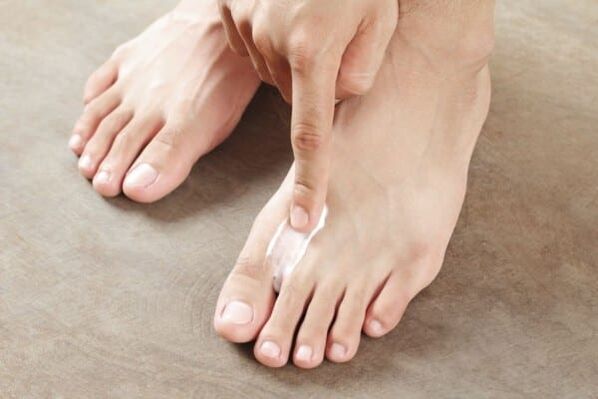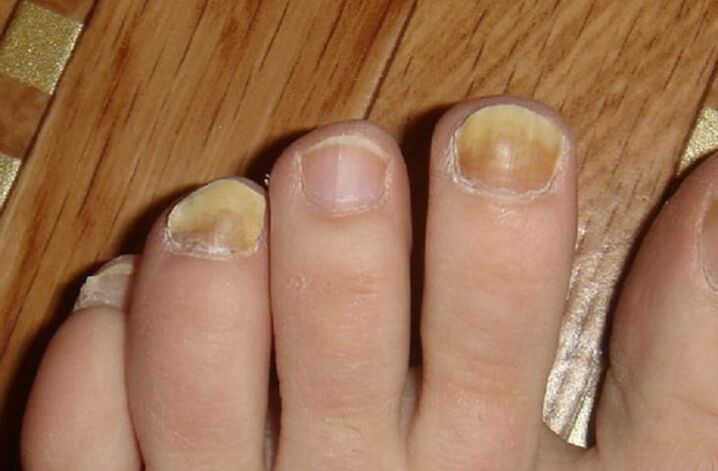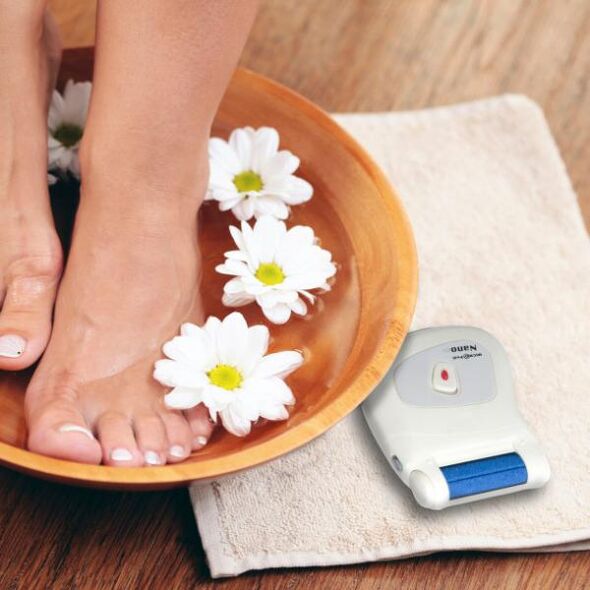Fungus on the skin of the feet is one of the most common infections. Fungus on the feet is characterized by vitality and ease of development. If you rely on statistics, then 20% of the world's population suffers from fungus.

What is a skin fungus?
Fungal diseases are infectious diseases that affect the skin. The most common type of fungus is mycosis. In medicine, this skin disease is divided into several types.
The fungus can adapt to almost all habitat conditions. Fungal spores can live for a long time in ordinary clothes or shoes. In most cases, fungal infections are exposed to the feet and nail plates of a person's feet.
How does mycosis develop?
The cause of foot mycosis is the fungi Trichophyton rubrum, T. Mentagrophytes and Epidermophyton floccosum. Mycosis can be contracted through contact with infected skin or after using any personal hygiene products.
Mycosis is characterized by the destruction of the skin in the form of peeling. This is due to the fact that the fungus penetrates deep under the skin, which leads to damage to the epidermis.
Yellow or white spots may appear on the nails. If the fungus infects the toes, then small bubbles of fluid are formed between them, which burst, healing is painful. Fungus on the feet is accompanied by an unpleasant odor. The symptoms of mycosis can be different depending on the type. To do this, you need to get to know each of them in more detail.
The main forms of mycosis:
- Interdigital mycosis.
- Squamous-hyperkeratotic form.
- Vesicular shape.
- Deleted form.
- Nail fungus.
Interdigital mycosis
The most common localization of interdigital fungi are intervals between 3, 4 and 5 fingers.
The main symptoms of interdigital mycosis:
- Forming a crack, which is covered with a white scaly thick film.
- A small amount of fluid can be released from the crack.
- Occurrence of diaper rash between the toes.
- Mild itching between the fingers.
Initially, the fungus between the toes may be dormant without any symptoms. However, gradually changes begin to be noticed - the skin becomes dry and rough, takes on a grayish tinge, cracks appear in rough places.
In addition, there is the so-called "wet" fungus between the fingers. This form is characterized by the formation of fluid-filled bubbles. These bubbles burst, thus creating the effect of a "wet" fungus. Such a fungus most often occurs after wearing tight unventilated shoes, as well as during times of severe stress.
Squamous-hyperkeratotic form
The squamous-hyperkeratotic form of mycosis is characterized by strong peeling and keratinization of the skin. This form of mycosis is very common, however, it most commonly affects people with atopic dermatitis.
The main symptoms of squamous-hyperkeratotic form of mycosis:
- Mild itching.
- Creating cracks in the skin of the feet.
- Pain.
- Dry skin.
- Skin peeling.
- Erythema with clear borders.
- Yellow shells.
- Onychomycosis - damage to the nail plate.
Vesicular shape
The vesicular form of the fungus is the rarest of all. Only 8% of all patients with mycosis are exposed to this type of disease. The vesicular form is characterized by the formation of a rash with liquid contents inside. When these vesicles rupture, erosions that can become infected appear.
The main symptoms of vesicular fungus:
- Formation of red or pink blisters.
- Inside the formation is a liquid of transparent color.
- The size of the blisters can reach a maximum of 1 cm in diameter.
- The rash may be accompanied by mild itching.
- Wet blisters.
This form of mycosis is dangerous, because there is a high probability that harmful bacteria and infections will get under the skin. In order to determine the vesicular form of mycosis, it is necessary to undergo special studies and take skin scraping for analysis, because this disease can be easily replaced by external symptoms with eczema or pustular psoriasis.
Deleted form
The erased form of the fungus is almost always the beginning of the development of foot disease - mycosis.
With the erased form of the fungus there are practically no visible symptoms, however, some of them can still be distinguished:
- The skin peels slightly between the toes.
- Formation of small cracks between the fingers that affect only the upper layers of the epidermis.
All these symptoms are not accompanied by itching or pain, so they do not cause any discomfort to the person.
Nail fungus
Toenail fungus is also a very common form of this disease. Such a fungus does not pose a particular threat to human health, but it can bring a lot of inconvenience.
Symptoms of nail fungus:
- Occurrence of dryness and peeling of the skin of the feet.
- Itching.
- Redness.
- Changing the shape of the nail.
- The color of the nails takes on a grayish-yellow hue.
- Nail plate cracking.
- Fragility of nails.
- Formation of crumbly mass under the nail.
- Formation of cavities under the nail plate.
- The stench.
If the foot fungus has become severe, then the patient's temperature begins to rise. Fungus on the feet, like any type of mycosis, can cause psoriasis or eczema.
What do skin fungus on the feet look like?
Despite the fact that foot fungus is a very common disease nowadays, not everyone knows exactly what it looks like. Many infected people do not even attach much importance when the first signs of a fungal infection appear. As mentioned earlier, there are several types of fungi.
Each species has its own symptoms:
- In the initial phase of the infection, redness, mild swelling and cracking appear on the skin.
- In the middle phase of the development of the fungus, peeling of the skin appears. The foot is covered with spots of white, pink or white.
- If the disease has already passed to the highest stage of its development, then the nail plates on the fingers begin to collapse and change their usual color. The skin on the feet begins to peel in large pieces. Deep and painful cracks appear.
Photography

Symptoms of foot fungus
To identify the fungus on the feet, it is necessary to pay attention to the basic symptoms:
- Redness of the affected areas of the skin.
- Skin peeling.
- Formation of blisters with liquid content.
- Nails change color and shape.
- Fragility and delamination of the nail plate.
Diagnosis
At the first manifestations of the symptoms of the fungus, you should consult a dermatologist. Sometimes, a visual examination is not enough to make an accurate diagnosis.
Some symptoms may indicate the presence of another skin condition. Therefore, a specialist in such cases should take a scrape and do a microscopy. Only after such studies can we clearly speak about the presence and form of fungal disease.
Treatment
It is necessary to start the treatment of the fungal disease only after a complete diagnosis by a specialist, who must prescribe various medications for the treatment of this disease. Treatment of fungus on the feet can consist of several methods.
These methods include:
- systemic therapy.
- local therapy.
- Folk remedies.
It is worth taking a closer look at each of them.
Systemic therapy
Systemic therapy involves the use of various antifungal drugs. Such drugs penetrate the bloodstream and kill fungal infections. Such agents can penetrate the platinum of the nail, which can remain for several weeks, gradually killing the fungus.
Effective remedies for fungus on the feet
Terbinafine and itraconazole are considered effective antifungal agents. These systemic drugs can cure a patient in two weeks.
It is important to note that systemic therapy is not prescribed for the following persons:
- Pregnant women.
- Breastfeeding.
- People suffering from liver disease.
- Elderly with comorbidity.
Ointments and creams
Systemic treatment of fungal diseases is recommended to be combined with local therapy. This method of treatment includes various creams and ointments, which can also have an antifungal effect. However, it is worth paying attention to the fact that if creams and ointments are used without the use of systemic drugs, then the treatment may be ineffective.
Topical drugs to control fungal infections are divided into 20 forms. In addition to creams and ointments, various sprays, gels, foams and varnishes are used to treat foot fungus.
When using a local fungal treatment, it is worth remembering that after applying any medicine on the skin, the feet should not be washed during the day.
Folk remedies

You can also cure the fungus on the skin of your feet with the help of folk remedies. To do this, you need to get to know them in more detail.
Folk remedies for the treatment of nail fungus:
- At night, a piece of kombucha is applied to the affected nails.
- Attach the cut kalanchoe leaf to the nails overnight.
Folk remedies for the treatment of fungus between the fingers:
- Wash the skin between your fingers and smear with birch tar.
- Make a decoction of plantain, yarrow, wormwood and chamomile. Make foot baths from the prepared broth.
Folk remedies for the treatment of foot fungus:
- At night, lubricate the affected areas of the skin with onion juice.
- Make a night compress of 20% propolis tincture.
Folk remedies for the treatment of foot fungus:
- Take a foot bath with sea salt twice a day.
- Bathe your feet three times a day with a decoction of chamomile, oak bark and calendula.
Prevention
Fungi on the skin of the feet most often cause sweating. Even in the cold season, the cause of fungal diseases is well preserved. But high temperatures can kill the infection, so one way to prevent it is to boil it. Another method of prevention is to disinfect shoes with formalin. With this action the fungus dies after 20 minutes.
Conclusion
In conclusion, it is worth noting that fungal disease of the skin of the feet does not harm human health. Fungi only create discomfort. However, this infection should not be ignored. If the disease becomes severe, it can lead to pain and the development of other infections.





























